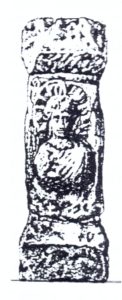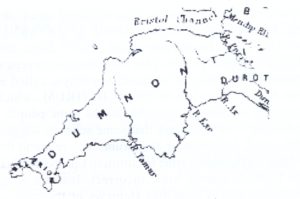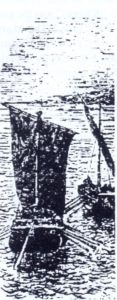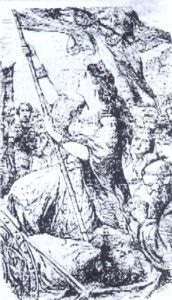THE HEBREW – CELTIC CONNECTION
A Missing Link In Fulfilled Prophecy
Language, Cultural, and Religious Ties!
In the 8th century, B.C., the Assyrian Empire was at its peak, and its armies threatened the nations on the eastern Mediterranean seaboard, including Israel. The Assyrians were a brutal, fearsome people, the most terrible, perhaps, in all the earth ‘s history. Conquered lands were literally plundered of everything of value – even people, who were taken to slavery in foreign lands. The wall murals of the Assyrians, some of which now bedeck the British Museum in London, depict scenes of horrible savagery and torture. Men were sometimes skinned alive, or impaled on poles to slowly die outside the gates of the city.
Famed archaeologist, Sir Austen Henry Layard, rediscovered and unearthed the ancient Assyrian cities, and graphically described the scenes on the wall murals he found: “Captives .., were stretched naked at full length on the ground, and whilst their limbs were held apart by pegs and cords they were being flayed alive. Beneath them were other unfortunate victims undergoing abominable punishments. The brains of one were apparently being beaten out with an iron mace, whilst an officer held him by the beard. A torturer was wrenching the tongue out of the mouth of a second wretch who had been pinioned to the ground. The bleeding heads of the slain were tied round the necks of the living who seemed reserved for still more barbarous tortures. ” (“Discoveries In The Ruins Of Assyria And Babylon,” p. 456)
Inhabitants of Palestine in those days were well aware that Assyria would only too soon conduct a similar brutal warfare against the eastern shore of the Mediterranean. Would not large numbers of Israelites migrate westward, by land and sea, to find safety for themselves and their families outside of the Assyrian sphere of influence?
Historical evidence indicates that did indeed happen. The authoritative Dictionary of Christ & The Gospel s relates, “LARGE NUMBERS OF ISRAELITES HAD BEEN CARRIED AWAY CAPTIVE BY THE ASSYRIANS AND BABYLONIANS … BUT A MUCH LARGER DISPERSION WAS DUE TO VOLUNTARY EMIGRATION.” ( vol. 1, P.692 )
Yes, more Israelites emigrated, migrated voluntarily out of Palestine, than even the large numbers of those taken away in the Assyrian and Babylonian captivities. As it became clear that invasion and conquest by Assyria was imminent, Hebrews and Phoenicians emigrated westward to distant lands by the many hundreds of thousands, forming the foundation of European civilization.
These historical facts have been known for centuries, and a plethora of books by leading historians has documented “the Phoenician origin” of Western civilization. In actual fact, the Hebrew language is a Phoenician dialect, and the two are virtually identical; and as we will see, a great multitude of the “Phoenician” speaking early European colonists can be shown to be Hebrew. Famed historian, George Rawlinson , commented, “The Tyrians [Phoenicians] conceded to the Israelites a participation in the traffic which they had carried on for so long a time with the nations of the west. Two trading fleets were formed (I Kings 9:27; 10:22), to which each of the two nations contributed both ships and men.” (Phoenicia, pp.101-102) From these trading colonies grew and developed early European cities.
LANGUAGE LINK
In the 18th century, historian s discovered exciting proof of Phoenician-Celtic ties. An ancient Roman dramatist, Titus Maccius Plautus (died 184 B.C.) wrote a play, the Penulus, in which he placed then-current Phoenician into the speech of one of his characters. In the 18th century, linguists noticed the great similarity between that Phoenician and the early Irish Celtic language. In the adjacent box is a sample given by historian Thomas Moore’s, History of Ireland, showing the connection between these languages. Leading 18th and 19th century scholars, such as Gen. Charles Vallancey, Lord Rosse, and Sir William Betham, also wrote on this subject. Vallancey, for instance, speaks of , “The great affinity found in many words, nay whole lines and sentences of this speech, between the Punic [Phoenician] and the Irish.” Famed historian, George Rawlinson, added that this and other inscriptions are “READILY EXPLICABLE, IF HEBREW BE ASSUMED AS THE KEY TO THEM, BUT NOT OTHERWISE .” (Phoenicia, p. 327)
THE SIMILARITY BETWEEN THE EARLY IRISH-CELTIC AND THE SECOND CENTURY, B.C., HEBREW-PHOENICIAN LANGUAGE AS SHOWN BY THE PENULUS OF PLAUTUS:
PHOENICIAN OF PLAUTUS :
Byth lym mo thym nociothii nel ech an ti daisc machon Ys i do iebrim thyfe lyth chy lya chon temlyph ula.
EARLY IRISH-CELTIC:
Beth horn’ mo thirne nociaithe, niel ach an ti dairie mae coinne Is i de leabhraim tafach leith, chi his con teampl uibh uhla.
In 1772, General Charles Vallancey, a leading Irish scholar of the day, published his famous work, “Essay On The Antiquity Of The Irish Language, Being A Collation Of The Irish With The Punic (Hebrew) Language.” In his opening remarks he states, “On a collation of the Irish with the Celtic, Punic, Phoenician and Hebrew languages , the strongest affinity, (nearly a perfect identity in very many Words) will appear ; it may therefore be deemed a Punic-Celtic compound.” Vallancey continues, ‘from the Hebrew proceeded the Phoenician , “from the Phoenician, Carthaginian, or Punic was derived the Aeolian, Dorian and Etruscan, and from these was formed the Latin … Of the Roman Saxon capital letters, the Irish use but three, all the others bear a very great resemblance to the primitive Hebrew and Phoenician.” (p. 2-3) Modern language scholars have confirmed that there is a definite connection between the Celtic and Hebrew, as we have shown in our tract, “Hebrew And English.”
RELIGIOUS LINK
Since it is true that Hebrews and Phoenicians migrated to Europe in large numbers in ancient times, there must be religious and cultural ties, and in fact, such connections abound . Dr. Thomas Moore’ s, History of Ireland (p. 40), relates: “That most common of all Celtic monuments, the Cromlech … is to be found not only in most parts of Europe, but also in Asia,” including Palestine. “Not less ancient and general, among the Celtic nations, was the circle of upright stones, with either an altar or tall pillar in the centre, and, like its prototype at Gilgal [ancient Israel], serving sometimes as a temple of worship, sometimes as a place of national council or inauguration … The rough, unhewn stone … used in their circular temples by the Druids, was the true, orthodox observance of the divine command delivered to Noah , ‘If thou wilt make me an altar of stone, thou shallt not build it of hewn stone.” (Ex. 20:25) Dr. Beauford , in Druidism Revived, says, “It is remarkable that all the ancient altars found in Ireland, and now distinguished by he name of Cromlechs or sloping stones originally called Bothal, or the House of God, and they seem to be of the same species as those mentioned in the Book of Genesis, called by the Hebrews, Bethel , which has the same signification as the Irish Bothal.” The Bible (Judges 9:6; 2Ki. 11:14; 2Chon. 23:13) indicates that Hebrew kings were crowned either standing upon or next to a pillar of stone. “The practice of seating the new king upon a stone, at his initiation, was the practice in many of the countries of Europe…. The monarchs of Sweden sat upon a stone placed in the centre of twelve lesser ones, and in a similar kind of circle the Kings of Denmark were crowned.” (Moore, ibid., p. 42) Note also the significant Bible number, ‘twelve’ , which was common to both European Celts and the Hebrews.
The book, Identity of the Religions Druidical and Hebrew, adds, “Circular temples … abound in England and other parts of Europe. The most ancient account of them is to be found in the book of Exodus (24:4), “And Moses… builded an altar under the hill, and twelve pillars, according to the twelve tribes ..” (p.15) In Europe, Stonehenge, Avebury, and many other early Celtic sites were designed in a circular pattern. Groves were also features of both Hebrew and Celtic worship. The Bible tells us that Abraham “called on the everlasting God” (Gen. 13:4) from a grove planted by his own hand. Gideon worshipped God under an oak tree. (Judges 6:19-24)
The division of time into a seven-day week was practised by the Irish Celts, identical to the Hebrews. Dr. Thomas Moore comments that no other nation kept such a hebdomadal (seven day) cycle “excepting only among the family of Abraham ,” (ibid., p. 54) a remarkable proof of identity between the two peoples!
 Since early times, the Israelites sinned against God by adopting many of the pagan practices of their neighbours, and so we find evidence of both Hebrew and Canaanite culture among their descendants in Europe. (The Phoenician is the eastern branch of the Canaanitic people.) The ancient Baal pillar shown on the left is one of many such religious monuments which have been found from the Middle East to Ireland.
Since early times, the Israelites sinned against God by adopting many of the pagan practices of their neighbours, and so we find evidence of both Hebrew and Canaanite culture among their descendants in Europe. (The Phoenician is the eastern branch of the Canaanitic people.) The ancient Baal pillar shown on the left is one of many such religious monuments which have been found from the Middle East to Ireland.
There are many other examples, however, of customs linking the Celtic Druids specifically with Israel. English historian, William Borlase, in his “Antiquities Of Cornwall,” ( 1754) presented many pages of such evidence: Druids worshipped but one God and allowed no graven images, identical to the Hebrews, and in contradistinction with almost all other ancient religions. Consecration was by sprinkling with blood, as in the Old Testament Hebrew worship. Druid priests were clothed in white, similar to the Hebrew priest’s white ephod; sacrificial victims were bled to death, and the blood was collected in basins which served to sprinkle the altars; bulls were sacrificed, and the image of a bull (the heraldic sign of the Hebrew tribe of Ephraim) was carried into war. “While they performed their horrid rites of human sacrifice the drums and trumpets sounded without intermission, that the cries of the miserable victims might not be heard .” (Compare Jer. 7:31-32; the Hebrew /Phoenician place of human sacrifice was called Tophet, meaning ‘the drum’). They prayed with uplifted hands, examined entrail s for necromancy, and held t h e oak in veneration. The Druids used the magic wand in imitation of Moses ‘ rod , poured libations, sacrificed upon the tops of rocks, investigated truth by lots, anointed rock pillars with oil , and marked out boundaries with stones. (pp. 104-132, 161) In these and so many other distinctive ways, the religious customs of the Celts and Hebrews bear an unmistakable resemblance!
GEOGRAPHICAL LINK
 The early name of southwestern England was “Dumnoni,” or “Danmoni,” as shown by a portion of a map in Celtic scholar, John Rhys’ book, “Early Celtic Britain.” This comprises today the British counties of Cornwall and Devon.
The early name of southwestern England was “Dumnoni,” or “Danmoni,” as shown by a portion of a map in Celtic scholar, John Rhys’ book, “Early Celtic Britain.” This comprises today the British counties of Cornwall and Devon.
Highly respected historian William Camden remarked concerning Cornwall: That region, which according to the geographers, is the first of all Britain, and… was in ancient times inhabited by those Britons, whom Solinas called, Dunmonii , Ptolomy (called) Damnonii , or (as we find in some other copies), MORE TRULY DANMONII WHICH NAME DERIVED FROM THE EVER CONTINUING MINES OF TIN IN THIS TRACT, WHICH THE BRITONS CALL MOINA .” ( Britannia, p: 183)
This compound word is therefore composed of “moina,”a tin mine, and “Dan,” the people who mined the tin . So this most ancient region of England is properly called “DANMONT,” meaning , “DAN’S TIN-MINES.” That these early inhabitants known as “Dan” were in fact the Biblical tribe by the same name has been established by leading modern scholars such as Cyrus Gordon as shown in our tract “Ancient Hebrew Sea Migrations.” If these early colonists had actually been Phoenicians the region would have been called not Danmoni but “Fenimoni,” because the Phoenicians were known as the Punic or Feni civilization .
 Celtic scholar, John Rhys gives strong evidences of Hebrew colonization of the British isles in ancient times. “Ireland was known as IBERION”, he says (p.201). The ancient name of the Israelites was Ibri or Iberi (modern Hebrew), which is derived from the name“EBER” or “HEBER”, an ancestor and patriarch of that people. Mr. Rhys continues, “…in Ireland it was Ivernii in Ptolomy’s time; and he mentions a town there called Ivernis and a river Ivernios. To these may be added various forms of the name of the island, such as Juvenal s Iuuerna, distorted more usually by the Romans into Hibernia … THEIR EPONYMOUS ANCESTOR … is variously called… EBER, EMER, and HEBER.” (ibid., p. 262-3) Dr. Rhys discusses a region “just in the vicinity of St. David’s or Mnyw, called in the Welsh Chronicle MONT IUDEORUM , which contains an allusion probably to the same people.” (ibid., p. 226) Rhys says that some scholars suggest this word, ludeorum or Judeorum, may relate to the “Jutes,” a Germanic tribe in Northern Europe, but that he believes such a view incorrect. Instead, Rhys indicates that it identifies Hebrews of the tribe of Judah. Rhys adds, “…lastly we seem to have a trace of the same form in the Welsh Chronicle, sometimes called Annales Cambriae, when it calls Menevia or St. David’s Moni Iudeorum. WE NEED NOT BE HERE TROUBLED BY THE LOST TEN TRIBES OF ISRAEL, BUT… IT WOULD BE HARD TO PROVE THE CONTRARY.” (ibid ., p. 150)
Celtic scholar, John Rhys gives strong evidences of Hebrew colonization of the British isles in ancient times. “Ireland was known as IBERION”, he says (p.201). The ancient name of the Israelites was Ibri or Iberi (modern Hebrew), which is derived from the name“EBER” or “HEBER”, an ancestor and patriarch of that people. Mr. Rhys continues, “…in Ireland it was Ivernii in Ptolomy’s time; and he mentions a town there called Ivernis and a river Ivernios. To these may be added various forms of the name of the island, such as Juvenal s Iuuerna, distorted more usually by the Romans into Hibernia … THEIR EPONYMOUS ANCESTOR … is variously called… EBER, EMER, and HEBER.” (ibid., p. 262-3) Dr. Rhys discusses a region “just in the vicinity of St. David’s or Mnyw, called in the Welsh Chronicle MONT IUDEORUM , which contains an allusion probably to the same people.” (ibid., p. 226) Rhys says that some scholars suggest this word, ludeorum or Judeorum, may relate to the “Jutes,” a Germanic tribe in Northern Europe, but that he believes such a view incorrect. Instead, Rhys indicates that it identifies Hebrews of the tribe of Judah. Rhys adds, “…lastly we seem to have a trace of the same form in the Welsh Chronicle, sometimes called Annales Cambriae, when it calls Menevia or St. David’s Moni Iudeorum. WE NEED NOT BE HERE TROUBLED BY THE LOST TEN TRIBES OF ISRAEL, BUT… IT WOULD BE HARD TO PROVE THE CONTRARY.” (ibid ., p. 150)
Rhys also discusses early Celtic names and suggests that we “…compare Semitic names … compare the Hebrew.” (ibid., p. 259-260)
HISTORICAL LINK
One last fascinating connection with ancient Israel is suggested by Professor Rhys , who says, “the (Celtic) Kymry were for some time indifferently called Cambria or Cumbria, the Welsh word on which they are based being, as now written, Cymru… and is there pronounced nearly as an Englishman would treat it if spelled Kumry or KUMRI. ” (p . 142) As students of Old Testament history well know, “Kumri” or “Khumri”was the name of the Israelites in Assyrian texts. (see, “The March of Archaeology,” by C. W Ceram, p . 216) The virtual identity in spelling and sound between the Israelite “Khumri ,” and the Celtic “Kymry,” is too much of a coincidence to not have a relationship. Taken with the many other evidences, religious and cultural , the connection between the ancient Hebrews and Celts is too strong to be ignored .
In fact, it is no longer a question of, “Did Hebrews settle in Europe in ancient times?” but only a question of, “How many of the people of Europe are of Hebrew descent?” When considering the great numbers of early Israelites (see our tract , “The Real Diaspora”), and the Biblical promise of multitudinous seed (Gen. 26:4 , 32: 12; Ex. 32: 13; Jer. 33:22, etc.), it is evident that the Hebrew-Celtic connection is very significant.
Irish history records three main waves of colonization to that isle in ancient times: the Firboigs, of whom little is known , the Tuatha de Danaan (meaning ‘Tribe of Dan’; tuath means ‘tribe’), and the Milesians. The latter two peoples are known to have originated in Asia and may have been related. “The Story Of Ireland,” by  A.M. Sullivan, tells us this: “The Milesian colony .., were an Eastern people … they had passed from land to land, from the shores of Asia across the wide expanse of southern Europe, bearing aloft through all their wanderings the Sacred Banner which symbolized to them at once their origin and their mission, the blessing and , the promise given to their race. This celebrated standard, the ‘Sacred Banner of the Milesians, ‘ was a flag on which was represented a dead serpent and the rod of Moses… “(p.12)
A.M. Sullivan, tells us this: “The Milesian colony .., were an Eastern people … they had passed from land to land, from the shores of Asia across the wide expanse of southern Europe, bearing aloft through all their wanderings the Sacred Banner which symbolized to them at once their origin and their mission, the blessing and , the promise given to their race. This celebrated standard, the ‘Sacred Banner of the Milesians, ‘ was a flag on which was represented a dead serpent and the rod of Moses… “(p.12)
The Milesians traced their ancestry to “Gadelius”, whose grandfather was “the king of Scythia” (p. 13). Interestingly, Gad was a son of the patriarch Jacob and his descendants formed one of the tribes of Israel. The Greek word Scythia is derived from the Semitic, Skutha, and the Persian, Saca, which are terms for the Israelites. (see our tract, “The Real Diaspora” As if this wasn’t enough coincidence , the serpent symbol was a family heraldic emblem of the Israelite tribe of Dan (Gen. 49 : 17), whose descendants have been traced by leading modern American archaeologist Cyrus Gordon, to the Tuatha de Danaan of early Ireland! (see “Before Columbus ,” pp.108- 111)
SUMMARY
Therefore we can say that in all of these (and a multitude of other ways), the Celts and Hebrews bear a remarkable relationship. Since the Celts were spread over most of Europe, the cultural, historical, and theological implications of this truth are immensely significant. Write us for other tracts and literature on a variety of Bible subjects!
Courtesy of –
Bible Blessings Ministries –
Box 325, Royal Oak, Michigan 48068 USA

